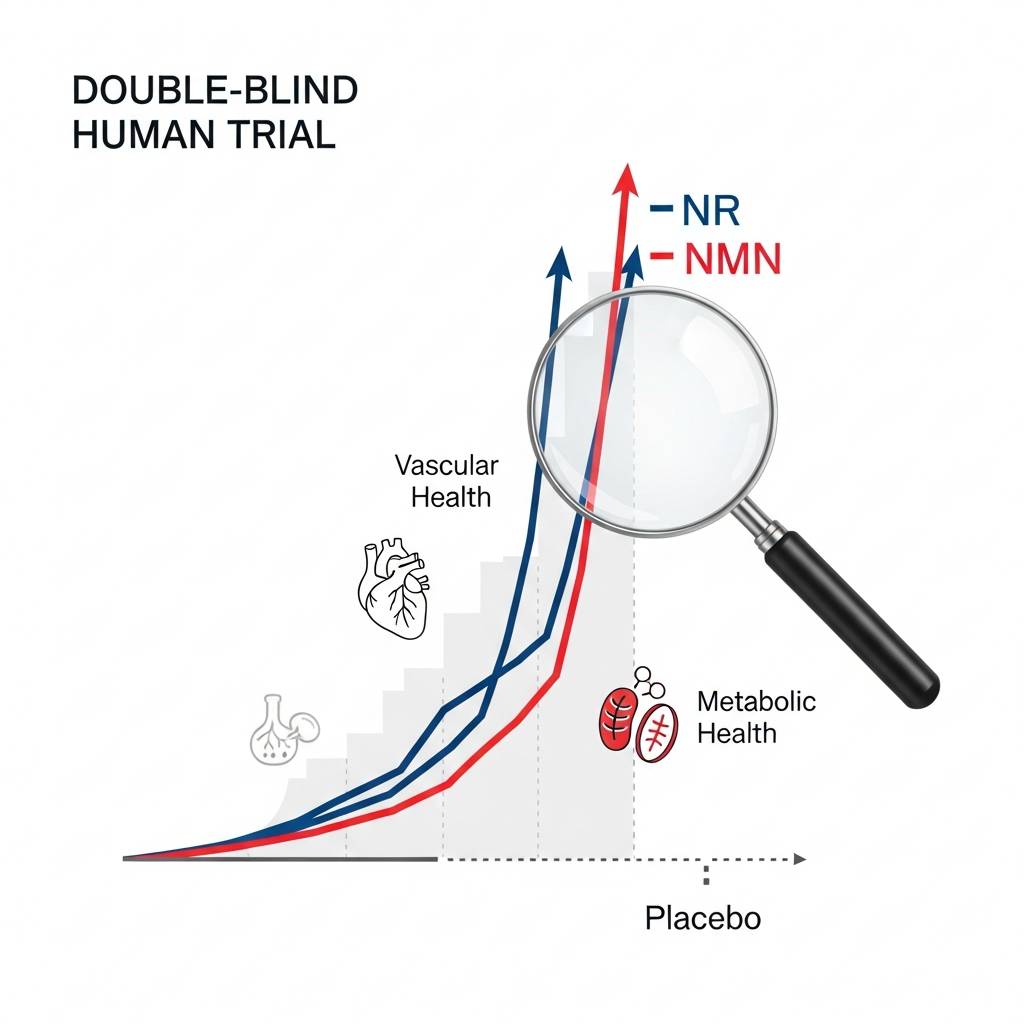Nicotinamide adenine dinucleotide (NAD) is a fundamental coenzyme present in every living cell, playing a central role in the biochemical processes that sustain life. It exists in two forms: NAD+ (oxidized) and NADH (reduced), cycling between these states to facilitate electron transfer during metabolic reactions. This redox cycling is critical for the production of ATP, the primary energy currency of the cell, and thus underpins virtually every cellular activity, from muscle contraction to neuronal signaling.
Beyond its role in energy metabolism, NAD serves as a key substrate for enzymes involved in DNA repair, gene expression regulation, and cellular signaling pathways. Among these enzymes are the poly(ADP-ribose) polymerases (PARPs), which detect and repair DNA strand breaks, and sirtuins, a family of NAD+-dependent deacetylases that influence metabolic health, stress response, inflammation, and longevity pathways. The availability of NAD+ therefore directly impacts genomic stability, cellular resilience, and the capacity of tissues to respond to physiological stressors.
Biochemistry of NAD and Energy Metabolism
NAD plays a pivotal role as a redox coenzyme, facilitating the transfer of electrons in critical metabolic pathways. In its oxidized form (NAD+), it accepts electrons from metabolic intermediates during processes such as glycolysis, the tricarboxylic acid (TCA) cycle, and fatty acid oxidation, converting into NADH. The reduced form, NADH, then donates these electrons to the mitochondrial electron transport chain, creating a proton gradient that drives ATP synthesis. This electron transfer is the cornerstone of cellular energy production, making NAD indispensable for sustaining life at the cellular level.
During glycolysis, glucose is metabolized into pyruvate, producing two molecules of NADH per glucose molecule. Pyruvate then enters the mitochondria where, through the TCA cycle, additional NADH and FADH2 molecules are generated. NADH contributes electrons to complex I of the electron transport chain, initiating a cascade of redox reactions that ultimately produce ATP. Insufficient NAD+ availability disrupts this flow, potentially leading to reduced ATP production, fatigue, and compromised organ function, particularly in energy-demanding tissues such as the brain, heart, and skeletal muscles.
Beyond energy production, NAD also acts as a cofactor for enzymes involved in DNA repair and epigenetic regulation. For instance, poly(ADP-ribose) polymerases (PARPs) consume NAD+ to detect and repair DNA strand breaks. Simultaneously, sirtuins utilize NAD+ to remove acetyl groups from histone and non-histone proteins, regulating gene expression, mitochondrial biogenesis, and stress resistance. This dual role highlights NAD+ as not only an energy mediator but also a critical regulator of cellular health and longevity.
NAD levels are influenced by nutrient availability, circadian rhythms, and cellular stress. Dietary precursors such as nicotinamide, nicotinamide riboside (NR), and nicotinamide mononucleotide (NMN) serve as substrates to maintain NAD+ concentrations, while exercise and intermittent fasting have been shown to enhance NAD+ biosynthesis and sirtuin activity. The integration of NAD-dependent pathways with energy metabolism underscores its centrality in supporting physical performance, cognitive function, and adaptive cellular responses to stress.
Research over the past two decades has highlighted the relationship between NAD+ levels and aging. Studies indicate that NAD+ concentrations decline progressively with age, leading to decreased mitochondrial function, reduced efficiency of DNA repair mechanisms, and impaired cellular signaling. This decline has been linked to age-related disorders, including neurodegenerative diseases, metabolic syndrome, and cardiovascular dysfunction. Consequently, restoring or maintaining NAD+ levels has become a focus in nutritional science, anti-aging research, and wellness industries.
In addition to its biochemical roles, NAD interacts with circadian rhythm regulators, influencing sleep-wake cycles, hormonal release, and overall metabolic homeostasis. Fluctuations in NAD+ levels throughout the day coordinate cellular timing mechanisms, suggesting that adequate NAD availability is essential not only for energy and repair but also for maintaining physiological rhythms that are critical to health. These multifaceted functions make NAD a molecule of interest for both researchers and consumers seeking strategies to optimize healthspan and longevity.
Historical Discovery and Early Research
The journey to understanding NAD began in the early 20th century. In 1906, scientists Arthur Harden and William Young observed a mysterious cofactor in yeast fermentation experiments that appeared to accelerate the conversion of sugar into alcohol. This discovery hinted at the existence of a vital cellular component that could influence metabolic efficiency, although its chemical identity remained unknown at the time. Over the following decades, intensive biochemical research led to the isolation and characterization of nicotinamide adenine dinucleotide, revealing it as a central coenzyme in oxidation-reduction (redox) reactions essential for energy metabolism.
During the mid-20th century, NAD was primarily studied in the context of its role in glycolysis, the tricarboxylic acid cycle (Krebs cycle), and mitochondrial oxidative phosphorylation. Researchers identified that NAD+ functions as an electron carrier, shuttling electrons from nutrient substrates to the mitochondrial electron transport chain, facilitating ATP production. These findings laid the foundation for understanding how cells derive energy from glucose, fats, and amino acids, positioning NAD as a key determinant of metabolic health.
The discovery of sirtuins in the 1990s revolutionized the perception of NAD. Sirtuins are NAD+-dependent enzymes that regulate gene expression, DNA repair, and cellular stress responses. Researchers found that these enzymes act as metabolic sensors, linking NAD+ availability to critical pathways involved in aging, inflammation, and metabolic adaptation. The realization that NAD+ is not merely a passive coenzyme but an active participant in longevity-related pathways sparked a surge of scientific interest, leading to studies exploring the potential of NAD+ precursors as therapeutic interventions for age-associated dysfunction.
Further research also highlighted the decline of NAD+ levels with age. Observational studies in both animals and humans revealed that this decline correlates with decreased mitochondrial efficiency, impaired DNA repair, and increased susceptibility to metabolic disorders and neurodegenerative conditions. The growing understanding of NAD’s multifaceted role underscored the importance of exploring dietary and supplemental strategies to maintain optimal cellular NAD+ concentrations throughout life, laying the groundwork for modern NAD supplementation research.
Age-Related NAD Decline and Its Implications
Research has consistently shown that NAD+ levels decline progressively with age, with reductions of approximately 30–50% observed in individuals between 40 and 60 years old. This decline has profound implications for cellular function, energy metabolism, and overall physiological resilience. Several interconnected mechanisms contribute to the reduction of NAD+ with age.
The increased activity of poly(ADP-ribose) polymerases (PARPs) due to accumulated DNA damage accelerates NAD+ consumption. DNA strand breaks, which naturally accumulate over time due to oxidative stress, UV exposure, and metabolic byproducts, stimulate PARPs to repair genetic material, depleting NAD+ reserves in the process. Secondly, chronic low-grade inflammation, commonly referred to as “inflammaging,” activates additional NAD+-consuming pathways, further reducing intracellular NAD+ concentrations. the expression of enzymes critical for NAD+ biosynthesis, such as nicotinamide phosphoribosyltransferase (NAMPT), declines with age, limiting the cell’s ability to regenerate NAD+ efficiently.
The consequences of diminished NAD+ are multifaceted. Reduced NAD+ impairs mitochondrial function, decreasing ATP production and cellular energy availability. This can manifest as fatigue, reduced physical endurance, and slower recovery from exercise or illness. Furthermore, lower NAD+ levels compromise the activity of sirtuins and other NAD+-dependent enzymes, weakening DNA repair mechanisms, disrupting circadian rhythms, and increasing susceptibility to age-related metabolic disorders, neurodegenerative diseases, and cardiovascular dysfunction.
Animal studies reinforce these findings. In aged mice, restoration of NAD+ through supplementation with precursors like NMN or NR has been shown to improve mitochondrial efficiency, enhance insulin sensitivity, and support cognitive function. In humans, preliminary trials indicate that increasing NAD+ can improve biomarkers related to metabolic health, vascular function, and energy metabolism, though long-term outcomes remain under investigation.
Understanding the age-related decline of NAD+ emphasizes the importance of maintaining NAD+ levels through dietary precursors, lifestyle interventions, and potentially supplementation. By supporting cellular energy production, genomic stability, and metabolic regulation, maintaining optimal NAD+ concentrations may help mitigate certain aspects of age-related functional decline.
Dietary Sources and NAD Precursors
Humans can maintain and restore NAD+ levels not only through endogenous synthesis but also by consuming specific dietary precursors. These compounds serve as building blocks for NAD+ biosynthesis and include nicotinamide (vitamin B3), nicotinic acid, nicotinamide riboside (NR), nicotinamide mononucleotide (NMN), and tryptophan. Each precursor follows distinct metabolic pathways, contributing to NAD+ production through the salvage, Preiss-Handler, and de novo pathways.
Nicotinamide and nicotinic acid are naturally present in common foods such as meat, poultry, fish, eggs, dairy products, and whole grains. Once ingested, they are converted into NAD+ through enzymatic processes in the liver and peripheral tissues. Nicotinamide riboside (NR) and nicotinamide mononucleotide (NMN), while less abundant in foods, have gained attention in scientific research for their ability to efficiently elevate cellular NAD+ levels in both animal and human studies. NR is found in trace amounts in milk and some fermented foods, whereas NMN is present in vegetables such as edamame, broccoli, and cabbage.
Tryptophan, an essential amino acid obtained from protein-rich foods, contributes to NAD+ synthesis via the kynurenine pathway, a multi-step process that converts tryptophan into nicotinic acid mononucleotide and eventually NAD+. While this pathway is functional, its efficiency declines with age and is influenced by factors such as chronic inflammation and metabolic stress, which can reduce NAD+ availability.
Lifestyle and dietary habits further modulate NAD+ levels. Regular consumption of foods rich in NAD precursors, combined with caloric balance and adequate protein intake, supports endogenous NAD+ biosynthesis. Additionally, research indicates that intermittent fasting and moderate exercise may enhance the activity of NAD+-biosynthetic enzymes like NAMPT, amplifying the effectiveness of dietary precursors.
In summary, while the human body can generate NAD+ through multiple pathways, dietary intake of NAD precursors plays a significant role in maintaining cellular energy, supporting DNA repair, and optimizing metabolic health, particularly in aging populations or individuals under metabolic stress. Understanding these nutritional strategies lays the groundwork for exploring targeted NAD supplementation in scientific and wellness contexts.
Scientific Research: Animal and Human Studies
Scientific investigation into NAD+ and its precursors has accelerated over the past two decades, providing compelling evidence for their role in cellular health, metabolism, and aging. Animal studies have been foundational in establishing these links. For instance, aged mice supplemented with nicotinamide mononucleotide (NMN) demonstrated significant improvements in mitochondrial function, insulin sensitivity, and muscle endurance. In addition, NMN restored NAD+ levels in multiple tissues, which correlated with enhanced cognitive performance and increased physical activity. Similar studies with nicotinamide riboside (NR) have shown improvements in neuronal survival, vascular function, and liver metabolism, suggesting that NAD+ precursors may have multi-organ benefits.
Human clinical studies, though more limited, are beginning to provide evidence supporting these findings. In one randomized controlled trial, oral NR supplementation increased blood NAD+ levels by 30–60% over several weeks. Participants reported improvements in energy levels, general well-being, and mild enhancements in physical performance, although objective measures varied across studies. Importantly, NR and NMN supplementation were generally well-tolerated, with only mild side effects such as nausea or transient digestive discomfort reported.
Researchers have also examined the effects of NAD+ precursors on age-related biomarkers. Studies indicate that supplementation can influence mitochondrial biogenesis, sirtuin activity, and markers of oxidative stress, suggesting potential mechanisms by which NAD+ supports metabolic and cognitive health. Animal experiments further reveal that long-term NAD+ restoration may delay the onset of age-related disorders, such as neurodegeneration, insulin resistance, and vascular dysfunction.
Despite promising results, limitations exist. Human trials are often small-scale, of short duration, and vary in dosage, formulation, and participant demographics. Consequently, while current evidence demonstrates that NAD+ precursors can safely boost NAD+ levels and may improve physiological function, more comprehensive, long-term clinical studies are required to confirm their efficacy in disease prevention and age-related functional decline.
The research underscores NAD+ as a central molecule in metabolic health and longevity. Both animal and human studies indicate that restoring NAD+ levels can positively influence energy metabolism, cognitive performance, and cellular repair mechanisms, establishing a scientific basis for further exploration of NAD+ maintenance strategies.
Potential Benefits of NAD Supplementation
NAD+ supplementation has gained significant attention for its potential to support various aspects of human health. While research is ongoing, multiple studies suggest that boosting NAD+ levels may provide benefits in energy metabolism, cognitive function, cardiovascular health, and cellular longevity.
One of the most well-established effects of NAD+ is its role in cellular energy production. By serving as a key coenzyme in mitochondrial oxidative phosphorylation, NAD+ supports ATP synthesis, which is critical for the energy demands of tissues such as the brain, heart, and skeletal muscles. Individuals with reduced NAD+ levels often experience fatigue and reduced endurance, particularly as they age. Supplementation with NAD+ precursors such as NR or NMN has been shown to restore NAD+ concentrations in these tissues, potentially improving energy availability and physical performance.
NAD+ also plays a crucial role in cognitive health. Through the activation of sirtuins and other NAD+-dependent enzymes, it supports mitochondrial function and neuronal survival. Animal studies indicate that NMN and NR supplementation can enhance memory, learning, and synaptic plasticity, while early human studies suggest improvements in focus and mental clarity. These effects may be particularly relevant in aging populations, where declining NAD+ levels are associated with neurodegenerative conditions such as Alzheimer’s disease and cognitive decline.
NAD+ contributes to cardiovascular and metabolic health. By influencing endothelial function, mitochondrial efficiency, and lipid metabolism, NAD+ helps maintain vascular elasticity, regulate blood glucose, and reduce oxidative stress. Research in mice and preliminary human trials suggest that NAD+ supplementation can improve insulin sensitivity, reduce vascular stiffness, and enhance overall metabolic homeostasis.
NAD+ supports cellular repair and longevity mechanisms. By facilitating DNA repair through PARPs and activating sirtuins that regulate gene expression and stress responses, NAD+ helps maintain genomic stability and resilience to metabolic stress. While NAD+ supplementation is not a miracle cure for aging, it provides a scientifically grounded approach to supporting physiological function, healthy metabolism, and potentially slowing age-related functional decline.
Safety, Side Effects, and Considerations
While NAD+ supplementation is generally considered safe, it is essential to understand potential side effects, limitations, and considerations for different populations. Studies of nicotinamide riboside (NR) and nicotinamide mononucleotide (NMN) indicate that most individuals tolerate these compounds well, even at relatively high doses. Reported side effects are typically mild and transient, including nausea, gastrointestinal discomfort, headaches, and occasional fatigue. These symptoms often resolve when the dosage is adjusted or the supplement is taken with food.
Long-term safety data are still limited, particularly in older adults or individuals with chronic health conditions. People with liver or kidney disorders, metabolic syndromes, or those taking medications that influence NAD+ metabolism should consult healthcare providers before initiating supplementation. Additionally, the quality and purity of supplements are critical. Not all commercially available NR or NMN products undergo third-party testing, and variations in dosage, bioavailability, and formulation may influence both efficacy and safety.
Another important consideration is individual variability. Genetic differences, lifestyle factors, and baseline NAD+ levels can affect how an individual responds to supplementation. For example, individuals with compromised mitochondrial function or chronic inflammation may experience different outcomes compared to otherwise healthy adults. Monitoring responses over time, adjusting dosages, and integrating lifestyle factors such as diet, sleep, and exercise can optimize the benefits of NAD+ supplementation.
It is also essential to emphasize that NAD+ supplementation is not a substitute for a healthy lifestyle. While it may enhance cellular function and metabolic resilience, long-term health outcomes depend on a combination of balanced nutrition, regular physical activity, stress management, and adequate sleep. By integrating NAD+ precursors with these foundational practices, individuals may more effectively support cellular energy, cognitive function, metabolic health, and overall well-being.
NAD+ supplementation offers a promising and scientifically grounded approach to support health. However, careful consideration of dosage, individual variability, product quality, and lifestyle factors is crucial to maximize safety and efficacy.
Lifestyle Factors That Influence NAD Levels
Beyond dietary intake and supplementation, lifestyle factors play a crucial role in maintaining and optimizing NAD+ levels. Scientific research indicates that exercise, caloric management, sleep patterns, and stress regulation can all influence NAD+ biosynthesis, recycling, and consumption, highlighting the interplay between daily habits and cellular health.
Exercise is one of the most effective natural modulators of NAD+ levels. Both aerobic and resistance training have been shown to enhance mitochondrial function and increase NAD+ concentrations in skeletal muscle and other tissues. Physical activity stimulates the expression of nicotinamide phosphoribosyltransferase (NAMPT), a key enzyme in the NAD+ salvage pathway, thereby supporting the continuous regeneration of NAD+ from its precursors. Regular exercise also boosts sirtuin activity, promoting metabolic efficiency, stress resistance, and mitochondrial biogenesis.
Dietary patterns are equally important. Nutrient-rich diets that provide adequate levels of vitamin B3, tryptophan, and other NAD+ precursors facilitate endogenous NAD+ production. Intermittent fasting or caloric restriction has been shown to elevate NAD+ levels and activate sirtuins, contributing to improved metabolic flexibility and enhanced cellular repair mechanisms. Conversely, chronic overnutrition and high-sugar diets may deplete NAD+ and impair mitochondrial function, potentially accelerating age-related decline.
Sleep and circadian rhythm also influence NAD+ dynamics. NAD+ levels fluctuate naturally throughout the day, aligning with the body’s internal clock to regulate energy metabolism and gene expression. Disrupted sleep or irregular schedules can lead to misalignment of NAD+-dependent pathways, affecting mitochondrial efficiency, hormone regulation, and overall cellular health. Prioritizing consistent sleep patterns supports optimal NAD+ cycling and physiological balance.
Stress management is another key factor. Chronic psychological or oxidative stress activates NAD+-consuming enzymes, such as PARPs, leading to reduced availability for energy metabolism and repair processes. Practices such as mindfulness, meditation, and controlled breathing may mitigate excessive NAD+ consumption, enhancing resilience at the cellular level.
In summary, NAD+ levels are not solely determined by supplementation or diet. A holistic approach that integrates exercise, balanced nutrition, adequate sleep, and stress management is essential for sustaining optimal NAD+ availability, supporting energy production, genomic stability, and overall health across the lifespan.
Market Trends and Future Perspectives
The growing interest in NAD+ supplementation has led to a rapidly expanding market within the health, wellness, and longevity sectors. Over the past decade, consumer awareness of NAD+’s role in cellular energy, metabolic health, and aging has fueled demand for supplements containing nicotinamide riboside (NR) and nicotinamide mononucleotide (NMN). Market analyses indicate steady growth, with an increasing number of products targeting age-conscious adults, biohackers, and individuals seeking cognitive or metabolic support.
Recent trends highlight the development of enhanced formulations. Many products now combine NAD+ precursors with complementary compounds, such as resveratrol, pterostilbene, or Coenzyme Q10, aiming to synergistically improve mitochondrial function, sirtuin activation, and antioxidant capacity. Companies are also exploring sublingual, liposomal, and nanotechnology-based delivery systems to maximize bioavailability and absorption, addressing concerns that oral NAD+ precursors may undergo degradation before reaching target tissues.
Scientific research continues to shape market directions. Ongoing human clinical trials are investigating NAD+ supplementation for metabolic syndrome, neurodegenerative diseases, cardiovascular function, and general longevity. The accumulation of rigorous evidence will likely influence regulatory oversight, dosing recommendations, and product positioning, creating a more science-driven supplement landscape.
Consumer education has become a critical factor in market growth. As NAD+ is relatively complex and abstract compared to common vitamins, effective communication regarding its biological functions, mechanisms, and evidence-based benefits is essential for informed decision-making. This includes clear explanations of precursor types, recommended intake ranges, and lifestyle integration strategies, helping consumers set realistic expectations while avoiding misconceptions about NAD+ as a “miracle anti-aging molecule.”
The future of NAD+ research and market development appears promising. Advances in personalized nutrition, genetic profiling, and precision supplementation may enable targeted NAD+ interventions tailored to individual metabolic needs. Integration with lifestyle strategies, wearable health monitoring, and digital health platforms could further optimize outcomes, providing consumers with tools to support cellular health, metabolic resilience, and overall well-being.
Common Misconceptions and Clarifications
Despite increasing public interest in NAD+ and its precursors, several misconceptions persist, which can lead to unrealistic expectations or misuse. One common misunderstanding is that NAD+ supplementation can reverse aging completely. While research supports its role in improving cellular function, energy metabolism, and DNA repair, NAD+ supplementation cannot halt biological aging. Instead, it may help mitigate some age-related decline and support overall cellular resilience when combined with a healthy lifestyle.
Another misconception involves the immediate effects of NAD+ precursors. Some marketing materials suggest rapid improvements in energy or cognitive function, yet scientific evidence indicates that physiological changes occur gradually. NAD+ levels in tissues are influenced by baseline health, age, lifestyle factors, and the efficiency of biosynthetic pathways, so benefits may manifest over weeks or months rather than hours or days.
A further point of confusion is the equivalence of all NAD+ supplements. Not all products are created equal in terms of bioavailability, purity, and precursor form. For instance, nicotinamide riboside (NR) and nicotinamide mononucleotide (NMN) differ in how effectively they are absorbed and converted into NAD+ within cells. Therefore, choosing high-quality, tested supplements is critical to achieving intended outcomes.
Some consumers also mistakenly believe that NAD+ supplementation replaces the need for lifestyle interventions. In reality, factors such as exercise, balanced nutrition, sleep quality, and stress management remain fundamental to maintaining NAD+ levels and promoting metabolic health. Supplementation should be viewed as a complementary strategy rather than a standalone solution.
Concerns sometimes arise regarding long-term safety. While short-term studies indicate that NAD+ precursors are generally well-tolerated, comprehensive long-term data are still limited. Individuals should be informed about potential side effects, dosage considerations, and the importance of consulting healthcare providers if they have underlying health conditions.
By addressing these misconceptions, consumers can develop a more realistic understanding of NAD+, its role in cellular health, and how supplementation integrates with broader lifestyle and wellness strategies.
Conclusion and Practical Takeaways
NAD+ is a central molecule in human biology, playing essential roles in cellular energy production, DNA repair, metabolic regulation, and overall health resilience. Scientific research has demonstrated that NAD+ levels naturally decline with age, contributing to reduced mitochondrial efficiency, impaired DNA repair, and susceptibility to metabolic and neurodegenerative disorders. While supplementation with NAD+ precursors such as nicotinamide riboside (NR) and nicotinamide mononucleotide (NMN) can help restore NAD+ levels and support cellular function, it is most effective when combined with a balanced diet, regular exercise, adequate sleep, and stress management.
Understanding the multifaceted roles of NAD+ helps individuals make informed choices regarding supplementation and lifestyle interventions. Key takeaways include: maintaining nutrient intake rich in NAD+ precursors, integrating consistent physical activity, prioritizing sleep and circadian rhythm alignment, and approaching supplementation as a complementary strategy rather than a standalone solution. Being aware of product quality, dosage, and potential side effects ensures safe and effective use of NAD+ supplements.
As a trusted nutritional supplement manufacturer, ZOOMSHEAL Health is dedicated to supporting health and wellness through scientifically grounded formulations. We specialize in high-quality, rigorously tested dietary supplements, helping consumers and brands access products that promote cellular energy, metabolic balance, and overall vitality. By combining research-backed ingredients with stringent quality standards, we aim to provide solutions that empower individuals to maintain optimal health and well-being throughout the lifespan.
Maintaining NAD+ levels is a scientifically validated approach to support healthy metabolism, cognitive function, and longevity pathways. When integrated with thoughtful lifestyle practices and reliable supplementation, it offers a practical and actionable strategy to enhance cellular health and promote overall vitality.






